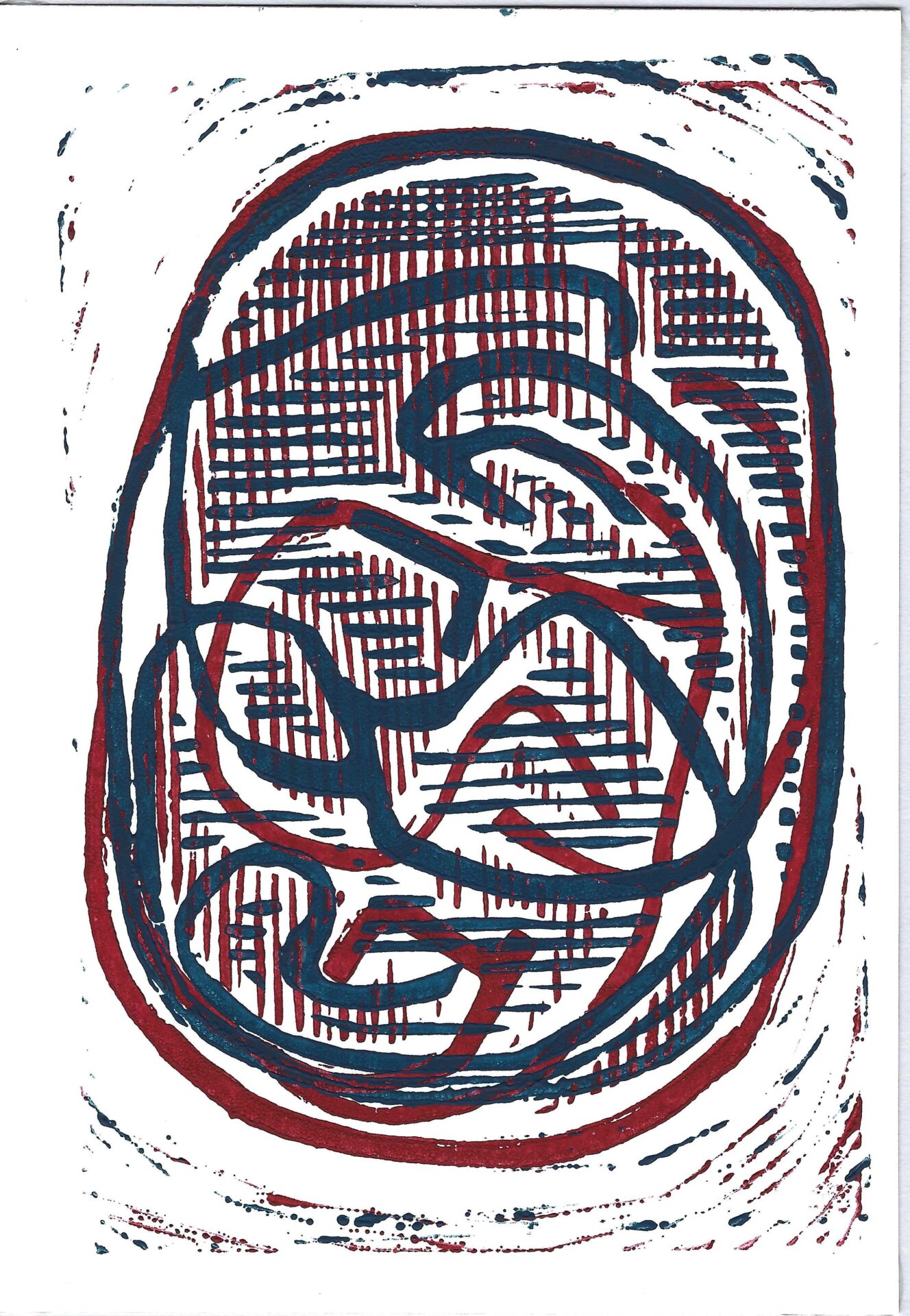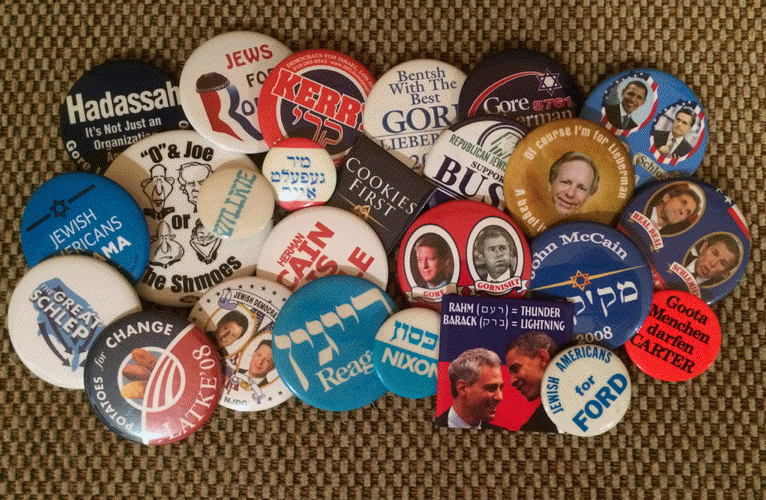
a selection of Jewish-themed campaign buttons 1940–2016
A briefer version of this blog post, with fewer illustrations, was published as “Ten Minutes of Torah” on October 27, 2016 on ReformJudaism.org.
Strangers don’t often interact on New York’s streets. Yet, this election season, I am often stopped and asked about my political lapel button.
Generally, I have found that while college students and 30-somethings wear lapel buttons for many causes year-round, older adults tend to do so only in election seasons. It is not surprising, then, that political parties and commercial button makers design buttons to attract the votes of American Jews.
The first confirmed presidential campaign to aim buttons at Jews was in 1900 when William Jennings Bryan ran against William McKinley. The Bryan campaign released a button in Yiddish. Only two copies are known to exist now.
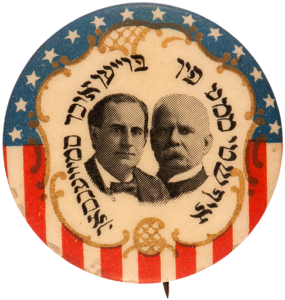
1900 Bryan-Stevenson jugate; translation (from a “Germanized” Yiddish with spelling errors): “I’m voting for Bryan also Stevenson”
Forty years passed before Jewish campaign buttons reappeared. In 1940, Wendell Willkie’s Republican supporters distributed one with his name in Hebraized letters. So many were made that they still sell inexpensively on eBay. Surprisingly, no buttons appeared that year in support of Roosevelt.
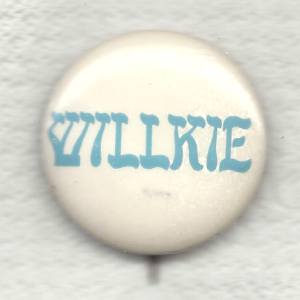
from the Wendell Willkie campaign of 1940
Supporters of Republican candidates appealed to Jewish voters by producing buttons with Jewish texts and themes, including Eisenhower buttons in Yiddish and Hebrew. Others in support of Nixon appeared in 1968 and 1972.
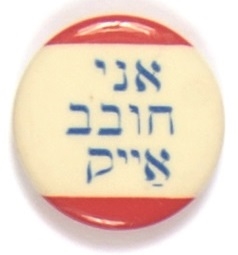
I like Ike (Hebrew)
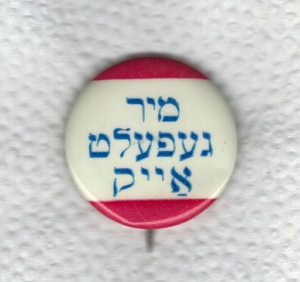
I like Ike (Yiddish)
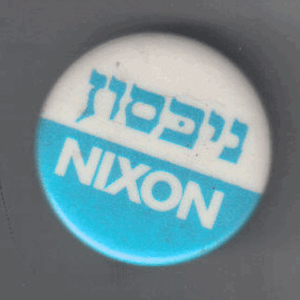
Nixon in Hebrew
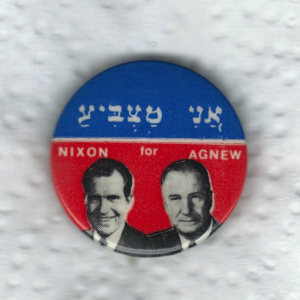
I’m voting for Nixon and Agnew (Hebrew). Comparable buttons appeared in various languages.
Throughout the 1960s commercial, novelty, and advocacy as well as political campaign buttons proliferated, both Jewish and general. In 1968, McGovern’s admirers stressed his support of Israel following the 1967 Six-Day War, though it was probably not an official campaign button. His detractors also produced a button.
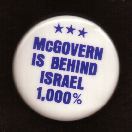
McGovern is Behind Israel 1,000%
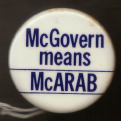
McGovern means McArab
Although neither appears to be an official button, in the 1976 campaign there was one button supporting Gerald Ford and one supporting Jimmy Carter. Ford’s said, “Jewish Americans for Ford.” Meanwhile, someone made a series of buttons in 15 languages stating: “All Good People Need [Jimmy] Carter.” The one labeled “Jewish” by the manufacturer actually was transliterated Yiddish: “Goota Menchen darfen Carter.” In 1980, the Reagan campaign created a button spelling his name in Hebrew.
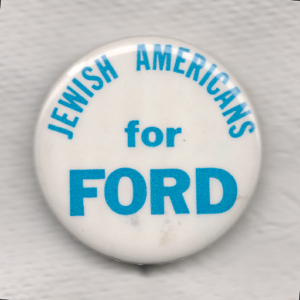
Jewish Americans for Ford
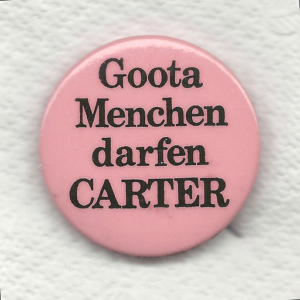
All Good People Need Carter (in “Jewish”)

Reagan (in Hebrew)
Oddly, I have never seen a Jewish-oriented button in support of either George H. W. Bush or Michael Dukakis from the 1988 election.
Beginning with the Clinton-Gore elections, the number and diversity of Jewish-themed buttons grew tremendously. Neither the supporters of George H.W. Bush in 1992 nor Bob Dole in 1996 circulated Jewish-oriented buttons to counter Clinton/Gore in either election. The Clinton campaign worked with the National Jewish Democratic Council (NJDC) to capture Jewish votes with a series of 50 buttons stating “Jewish Democrat and Proud,” individualized with the name of each state.
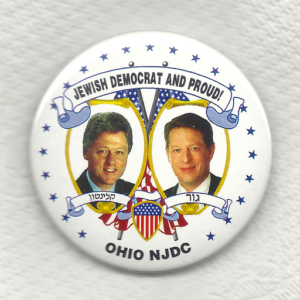
Jewish Democrat and Proud (Ohioans support Clinton & Gore)
When Vice President Al Gore selected Senator Joe Lieberman as his running mate in 2000, button makers relished the novelty of a Jewish candidate. The campaign produced at least one official Jewish-themed button. In addition, independent button manufacturers generated an unprecedented number of buttons with Jewish slogans. These included “Bentsh with the best…” and “Chutzpah! Gore Lieberman 2000,” as well as “A bagel in every pot.” Even Liberman’s wife Hadassah’s name was used creatively. The Bush-Cheney ticket did not counter with buttons. Yiddish puns and word-play contrasted the two candidates with “Gore vs. Gore-nisht” (Gore vs. Nothing).
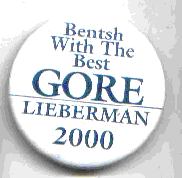
Bentsh With The Best
Gore Lieberman 2000
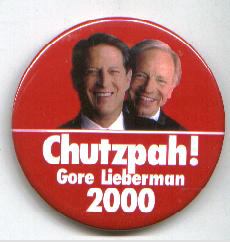
Chutzpah!
Gore Lieberman
2000
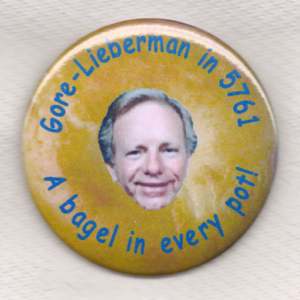
Gore-Lieberman in 5761
A bagel in every pot!
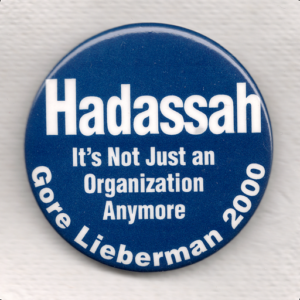
Hadassah
It’s Not Just an
Organization
Anymore
Gore Lieberman 2000
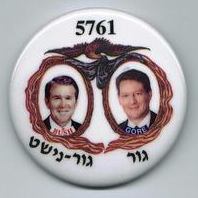
5761
גור גור-נישט
The 2004 election saw both the Bush and Kerry campaigns creating Jewish buttons. While some emerged from the official campaign or its surrogates, others were produced outside the campaigns. The Yiddish word-play contrast for this election was “Real Deal [Kerry] vs. Schlemiel [Bush].”
![Republican Jewish Coalition of Northern California [for] President George W. Bush](http://www.davka.org/wp-content/uploads/2016/10/y628.Republican-Jewish-Coalition-Northern-California-for-Bush-300x300.png)
Republican Jewish Coalition of Northern California [for] President George W. Bush
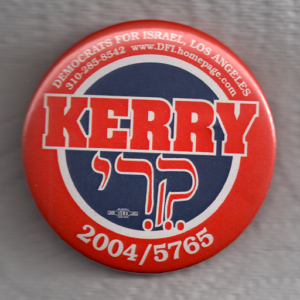
DEMOCRATS FOR ISRAEL, LOS ANGELES
210−285−8542 www.DFI.homepage.com
KERRY
קרי
2004⁄5765
![The Real Deal [vs] Schlemiel www.NJDC.org](http://www.davka.org/wp-content/uploads/2016/10/1379.Schlemiel-300x300.gif)
The Real Deal [vs] Schlemiel
www.NJDC.org
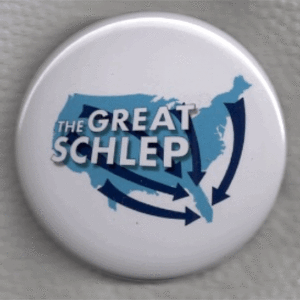
The Great Schlep
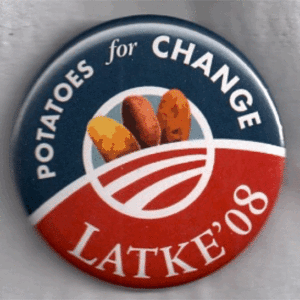
Potatoes for Change Latke’08
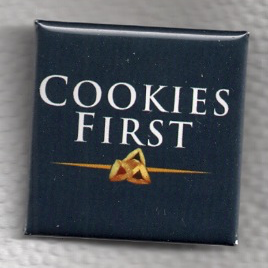
Cookies First
![RAHM [רעם] = THUNDER BARAK [ברק] = LIGHTNING](http://www.davka.org/wp-content/uploads/2016/10/x582.ThunderLightning-300x300.gif)
RAHM [רעם] = THUNDER
BARAK [ברק] = LIGHTNING
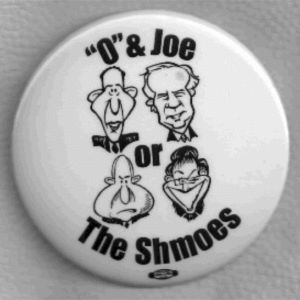
“O” & Joe
or
The Shmoes
Obama’s 2012 re-election campaign was significantly more restrained, releasing only a few Jewish-oriented buttons. The Romney campaign? None. Independent button makers also made fewer that year. Though the Herman Cain button, “Herman Cain is Able,” was perhaps the most creative (even though it presents a strange mental image: after killing his brother he becomes him?), the slogan proved untrue and he was unable to win the Republican nomination. That campaign’s Yiddish button from independent button maker Adam Fine contrasted “Barack” and “Schlock” [Romney].
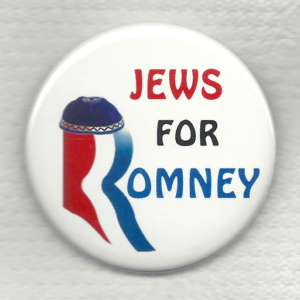
Jews for Romney

Herman
Cain
Is
Able
2012
![Barack [vs] Schlock Obama 2012](http://www.davka.org/wp-content/uploads/2016/10/x812.BarackSchlock-300x300.png)
Barack [vs] Schlock
Obama
2012
With only a few weeks until the election, when you pin on your Jewish-themed lapel button, you will know you are participating in a time-honored American-Jewish tradition.
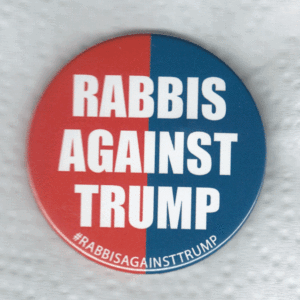
Rabbis
Against
Trump
#RabbisAgainstTrump
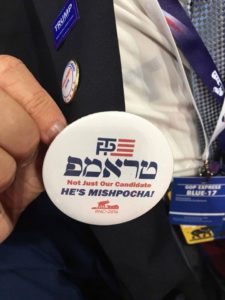
טראמפ
Not Just Our Candidate
He’s Mishpocha!
NRC 2016
![אני איתה [I'm with her] njdc.org](http://www.davka.org/wp-content/uploads/2016/10/y730.WithHer-300x300.gif)
אני איתה
[I’m with her]
njdc.org
![הילרי [Hillary] njdc.org](http://www.davka.org/wp-content/uploads/2016/10/y731.Hillary-300x300.gif)
הילרי
[Hillary]
njdc.org
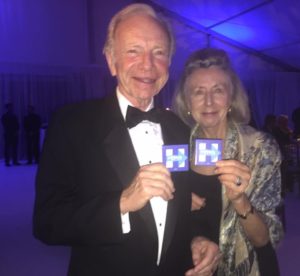
Joe and Hadassah Lieberman showing off their “Jewish Women for Hillary” buttons.
![Mensch [vs] Meshuggener Hillary 2016](http://www.davka.org/wp-content/uploads/2016/10/y724.Mensch-Meshuggener-300x300.png)
Mensch [vs] Meshuggener
Hillary
2016
Most of these buttons are from my own collection. I am not one of the two people who owns the William Jennings Bryan button. I do not (yet) have the Hebrew “I Like Ike” button. I do not know of anyone who has the Trump button released at the convention.
If you do not have time — before the election — to purchase buttons you can wear on your clothes, feel free to share the images of these buttons on your Facebook pages.

